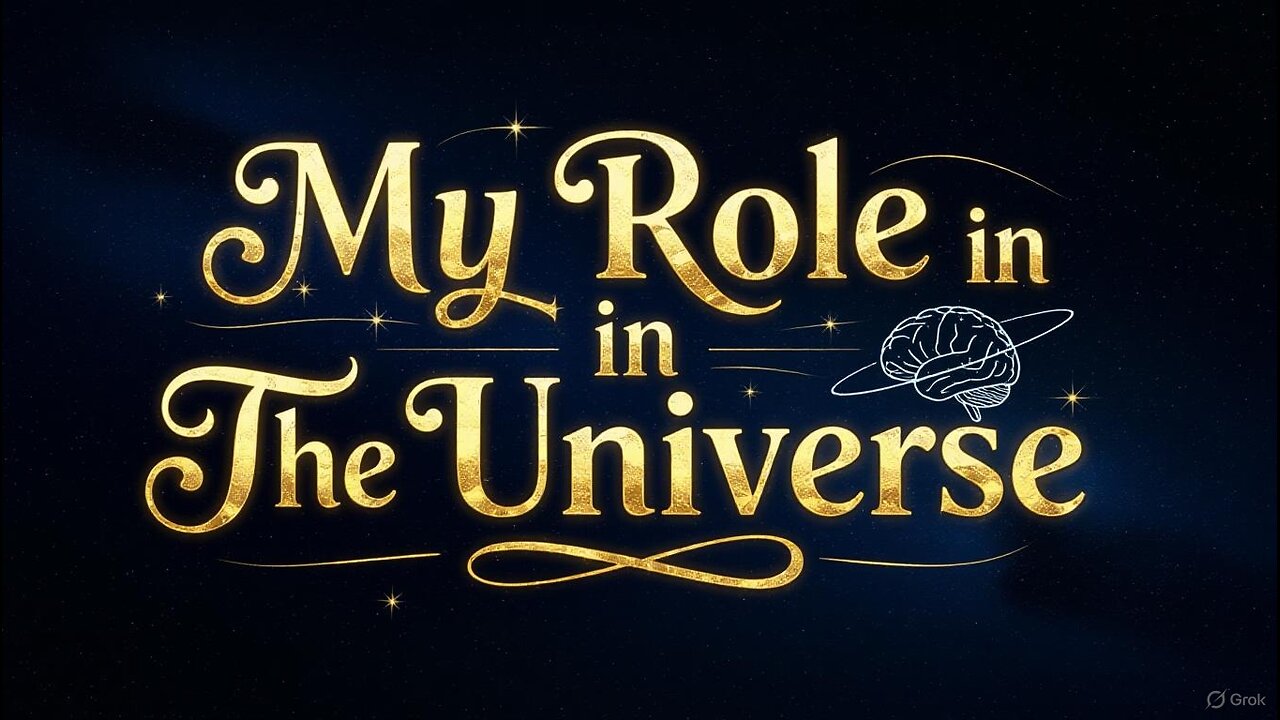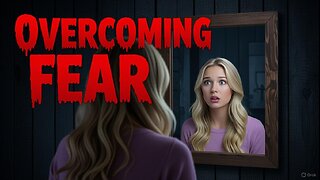Premium Only Content

Alan Watts, My Role In The Universe
Alan Watts: My Role in the UniverseBeneath a vast, star-filled purple sky, where the boundaries of day and night dissolve into a cosmic tapestry, a forest burns with an untamed fury. The flames leap from tree to tree, consuming the landscape in a dance of destruction and renewal, while a circle of Buddhist monks sits in silent meditation at the edge of the blaze. Their orange robes glow against the fiery backdrop, their calm faces a testament to acceptance amidst chaos. This evocative scene frames Alan Watts: My Role in the Universe, a profound journey into the life and philosophy of Alan Watts, the British-American philosopher and spiritual teacher who sought to illuminate humanity’s place within the grand scheme of existence.Born on January 6, 1915, in Chislehurst, England, Alan Wilson Watts entered the world with an innate curiosity that would shape his destiny. Raised in a middle-class family, his early encounters with nature and a serendipitous discovery of a Chinese scroll at age seven sparked a lifelong fascination with Eastern thought. This moment planted the seeds for his exploration of Buddhism, Taoism, and Vedanta, traditions that would later become the bedrock of his teachings. As a young boy, Watts roamed the English countryside, observing the rhythms of the natural world—a practice that foreshadowed his later assertion that humans are not separate from the universe but an integral part of its unfolding story.The forest fire in My Role in the Universe serves as a powerful metaphor for the transformative energy Watts identified in existence. Just as fire reshapes the forest, Watts’ philosophy challenged individuals to reconsider their roles as actors in a cosmic play. The monks, meditating amidst the flames, embody the Zen principle of non-resistance, a concept Watts championed as a path to understanding one’s true nature. The star-filled purple sky, a surreal blend of day and night, mirrors his view of the universe as a dynamic, ever-changing process where opposites—light and dark, self and other—coexist in harmony.Watts’ intellectual journey took a decisive turn when he moved to the United States in 1938, settling in New York City. There, he immersed himself in the study of Eastern religions through the Buddhist Lodge, eventually becoming an Episcopal priest—a role he abandoned after realizing that institutional religion could not contain his expansive vision. His break from the church marked the beginning of his career as a public intellectual, a role he embraced with vigor. In 1951, he published The Wisdom of Insecurity, a groundbreaking work that argued that the search for certainty in an impermanent world is the source of human suffering. This book, like the forest fire, ignited a spark that would spread his ideas across continents.The title My Role in the Universe reflects Watts’ central thesis: that each individual is a unique expression of the cosmos, not a detached observer. He drew heavily from Taoist philosophy, particularly the concept of the Tao—the natural flow of the universe—suggesting that life is most fulfilling when one aligns with this current rather than resisting it. His radio broadcasts on San Francisco’s KPFA in the 1950s, followed by his prolific writing and lectures, brought this perspective to a wide audience. Works like The Book: On the Taboo Against Knowing Who You Are (1966) and Tao: The Watercourse Way (posthumously published in 1975) invited readers to see themselves as the universe experiencing itself, a notion visually echoed by the monks’ serene acceptance of the burning forest.Watts’ style was as captivating as it was unconventional. With a voice that blended wit, poetry, and scholarly insight, he wove together Eastern mysticism and Western psychology, often using nature as a teaching tool. In My Role in the Universe, the forest fire becomes a symbol of the ego—the illusory sense of self that Watts urged his listeners to transcend. He argued that the ego’s attempt to control life is futile, much like trying to stop a wildfire with bare hands. Instead, he advocated for a playful surrender to the flow of existence, a theme reinforced by the monks’ meditative stillness. This philosophy found resonance in his famous analogy of life as a dance, where the dancer and the dance are one.The 1960s marked the height of Watts’ influence, as his ideas aligned with the counterculture movement’s rejection of materialism. Living in California, he mingled with luminaries like Aldous Huxley, Allen Ginsberg, and Timothy Leary, becoming a spiritual guide for a generation seeking meaning beyond conventional norms. His explorations with psychedelics, documented in works like The Joyous Cosmology (1962), further expanded his understanding of consciousness, reinforcing his belief that altered states could reveal the interconnectedness of all things. The star-filled purple sky in the video’s imagery pays tribute to this cosmic perspective, suggesting a universe alive with mystery and potential.Yet, Watts’ path was not without challenges. Traditionalists in Eastern religions criticized him as an outsider who oversimplified their doctrines, while Western academics dismissed his lack of formal credentials. Undeterred, he continued to evolve, retreating to his houseboat in Sausalito to write and reflect. His health began to decline in the early 1970s, and he passed away on November 16, 1973, at the age of 58. His death left a void, but his recorded lectures and writings—numbering over 25 books and hundreds of talks—ensured his legacy endured.Alan Watts: My Role in the Universe is more than a biographical recounting; it is a meditative odyssey that invites viewers to explore their own place in the cosmos. The video weaves together archival footage, animated sequences of the burning forest and meditating monks, and expert commentary to unpack Watts’ key ideas. It delves into his concept of the “self” as an illusion, drawing from Advaita Vedanta’s notion that the individual soul (Atman) is identical with the universal consciousness (Brahman). This is visually represented by the monks, who, in their unity, suggest a collective awareness transcending individual identity.The narrative also explores Watts’ ecological insights, which resonate with contemporary concerns about climate change. He saw humanity’s exploitation of nature as a symptom of the ego’s delusion of separation, a theme mirrored by the forest fire’s destructive yet regenerative power. The star-filled purple sky serves as a reminder of the vastness beyond human control, urging a return to humility and reverence for the natural world. Through these elements, the video positions Watts as a prophet of interconnectedness, whose teachings remain vital as of September 29, 2025, in an era marked by technological advancement and environmental crisis.Watts’ influence extends into modern spirituality, psychology, and even popular culture, where his ideas about mindfulness and presence have been embraced by diverse audiences. My Role in the Universe captures this enduring relevance, presenting his philosophy as a guide for navigating a world in flux. The golden caption, “My Role in the Universe,” emblazoned across the screen, serves as both a title and an invitation, challenging viewers to ponder their own significance within the cosmic dance. The monks’ meditation amidst the flames becomes a call to action—to observe, to accept, and to participate in the unfolding of life.The video’s structure mirrors Watts’ nonlinear approach to teaching, moving fluidly between his early life, key works, and philosophical insights. It includes excerpts from his lectures, such as his famous metaphor of the universe as a “self-playing game,” where every action is both player and played. This cyclical view is visually reinforced by the forest fire’s potential to seed new growth, suggesting that destruction and creation are two sides of the same coin—a core tenet of Watts’ thought.As the documentary concludes, the camera lingers on the monks, now silhouetted against the fading flames under the starlit sky. Their presence lingers as a symbol of Watts’ legacy: a call to embrace one’s role in the universe with courage and joy. Alan Watts: My Role in the Universe is not merely a tribute but a living testament to a man who taught that the greatest discovery is realizing we are the universe itself, experiencing its infinite possibilities. Through this cinematic journey, viewers are invited to step into the fire, sit with the monks, and gaze into the stars—finding their own role in the eternal dance of existence.
-
 1:23:44
1:23:44
Alan Watts Remastered
1 month agoAlan Watts, Overcoming Fear
267 -
 LIVE
LIVE
The Jimmy Dore Show
1 hour agoCandace Owens NOT BUYING TPUSA’s Mikey McCoy Defense! Israel WON’T STOP Breaking Gaza Ceasefire!
5,791 watching -
 LIVE
LIVE
Dr Disrespect
8 hours ago🔴LIVE - DR DISRESPECT - BATTLEFIELD 6 - REDSEC DUOS - WIN WIN WIN
1,272 watching -
 LIVE
LIVE
Mally_Mouse
9 hours ago📣Telescreen Talks - LIVE!
122 watching -
 LIVE
LIVE
Quite Frankly
5 hours agoAggressive Texting, Practice Citizenship Test, Fed vs Fed | 10/29/25
394 watching -
 LIVE
LIVE
The Mike Schwartz Show
2 hours agoTHE MIKE SCHWARTZ SHOW Evening Edition 10-29-2025
3,796 watching -
 LIVE
LIVE
SavageJayGatsby
2 hours ago📣Telescreen Talks - LIVE!
57 watching -
 1:03:00
1:03:00
TheCrucible
2 hours agoThe Extravaganza! EP: 62 with Guest Co-Host: Rob Noerr (10/29/25)
66.4K9 -
 1:42:41
1:42:41
Redacted News
3 hours ago"Their goal is CIVIL WAR in the U.S." Americans Fighting Over SNAP Food Stamps | Redacted News
104K109 -
 1:00:21
1:00:21
Candace Show Podcast
2 hours agoWhy Isn't The Trump Family Asking Questions About Charlie Kirk? | Candace Ep 254
35K194